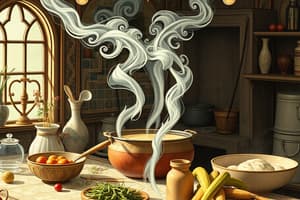Podcast
Questions and Answers
What is the purpose of starting the stock in cold water?
What is the purpose of starting the stock in cold water?
Why is it important to bring the stock to a simmer instead of allowing it to boil?
Why is it important to bring the stock to a simmer instead of allowing it to boil?
Why is it recommended to simmer the stock gently?
Why is it recommended to simmer the stock gently?
What is the purpose of skimming the stock during preparation?
What is the purpose of skimming the stock during preparation?
Signup and view all the answers
What is the role of mirepoix in preparing stocks?
What is the role of mirepoix in preparing stocks?
Signup and view all the answers
Why should the stock be strained carefully before use?
Why should the stock be strained carefully before use?
Signup and view all the answers
What is the purpose of cooling the stocks quickly?
What is the purpose of cooling the stocks quickly?
Signup and view all the answers
Which ingredient is described as the most important in a stock, providing flavor, nutrients, and color?
Which ingredient is described as the most important in a stock, providing flavor, nutrients, and color?
Signup and view all the answers
What gives brown stock its color?
What gives brown stock its color?
Signup and view all the answers
Which stock is characterized by slow cooking lean fish or shellfish bones?
Which stock is characterized by slow cooking lean fish or shellfish bones?
Signup and view all the answers
What is the primary liquid food generally served warm?
What is the primary liquid food generally served warm?
Signup and view all the answers
What is a mixture of coarsely chopped vegetables used in a stock to add flavor, nutrients, and color?
What is a mixture of coarsely chopped vegetables used in a stock to add flavor, nutrients, and color?
Signup and view all the answers
Study Notes
Stock Definition and Principles
- Stock is a flavorful liquid made by simmering bones and/or vegetables in a liquid to extract their flavor, aroma, color, body, and nutrients.
- Stocks are considered the chef's building blocks because they form the base for many soups and sauces.
Preparing Stocks
- Start the stock in cold water to allow proteins and impurities to dissolve and then rise to the surface for skimming.
- Bring the stock to a simmer using high heat, but do not allow it to boil.
- Simmer the stock gently to allow impurities to continue to rise to the top and be skimmed off.
- Skim the stock to remove impurities and improve clarity.
- Add mirepoix and spices to flavor the stock, with the mirepoix size depending on the cooking time.
- Strain the stock carefully to ensure cleanliness and clarity.
- Cool the stock quickly to prevent food-borne illnesses or souring.
- Store the stock properly in a refrigerator or freezer.
Stock Ingredients
- Nourishing element: the most important ingredient in a stock, providing flavor, nutrients, and color.
- Mirepoix: a mixture of coarsely chopped vegetables adding flavor, nutrients, and color.
- Bouquet garni: a combination of fresh herbs and vegetables tied in a bundle with butcher's twine.
- Liquid: usually water, making up the largest portion of the stock.
Stock Classification
- White stock: made from chicken, beef, veal, or fish bones simmered with vegetables, generally colorless.
- Brown stock: made from beef, veal, chicken, or game fowl, getting color from roasting ingredients without water in a hot oven.
- Fish stock: made by slow cooking the bones of lean fish or shellfish.
- Vegetable stock: an important addition to many healthful dishes, forming the base for many vegetarian and vegan dishes.
Soup Definition
- Soup is a primary liquid food, generally served warm, but can also be cold.
- Made by combining ingredients such as meat and vegetables with stock, juice, water, or another liquid.
- Hot soups are characterized by boiling solid ingredients in liquids in a pot until the flavors are extracted.
Studying That Suits You
Use AI to generate personalized quizzes and flashcards to suit your learning preferences.
Description
Learn about the principles of preparing flavorful stocks, the chef's building blocks for many soups and sauces. Understand why it's important to start the stock in cold water and how it affects the final outcome.




